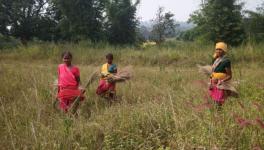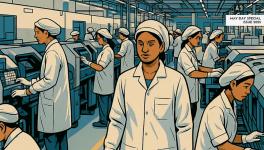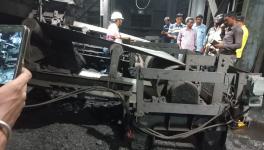Jharkhand: A Dust Dilemma Leading Workers to a Slow Death due to Silicosis
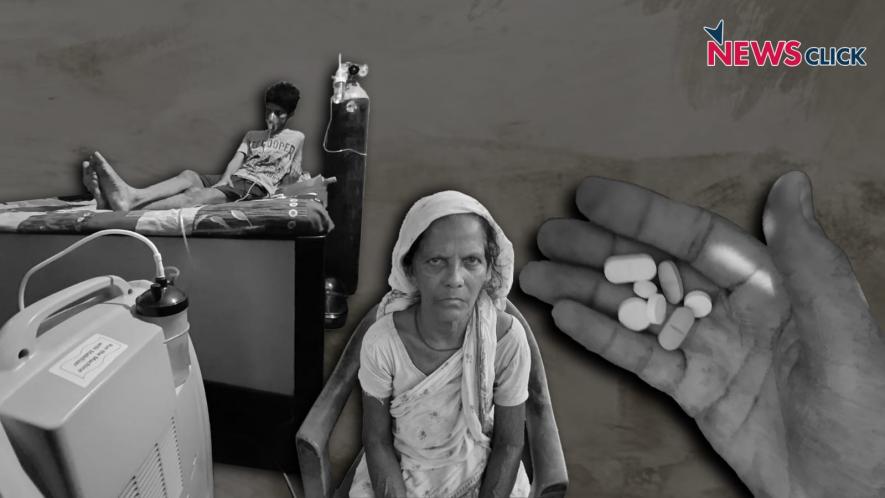
Victims of the killer Dust
Jharkhand: Kunal, 34, lay on his bed, keeping the AC's temperature at 21 degrees on a scorchy summer afternoon. Once a healthy man, as seen in the pictures on the room's wall, Kunal's body had grown extremely pale. Lying down in his shorts, Kunal had an oxygen mask on his mouth almost permanently, so much so that even to go to the washroom, the oxygen concentrator would keep him company.
An oxygen cylinder was beside him in case the electricity went off. Otherwise, the machine was on permanently. Kunal used to work in Bangalore until a few years back when he decided to return home. Struggling to find a job, he finally found a factory with an opening.
"The Krishna and Krishna Udyog hired me; my job was to do the billings and take care of payments."
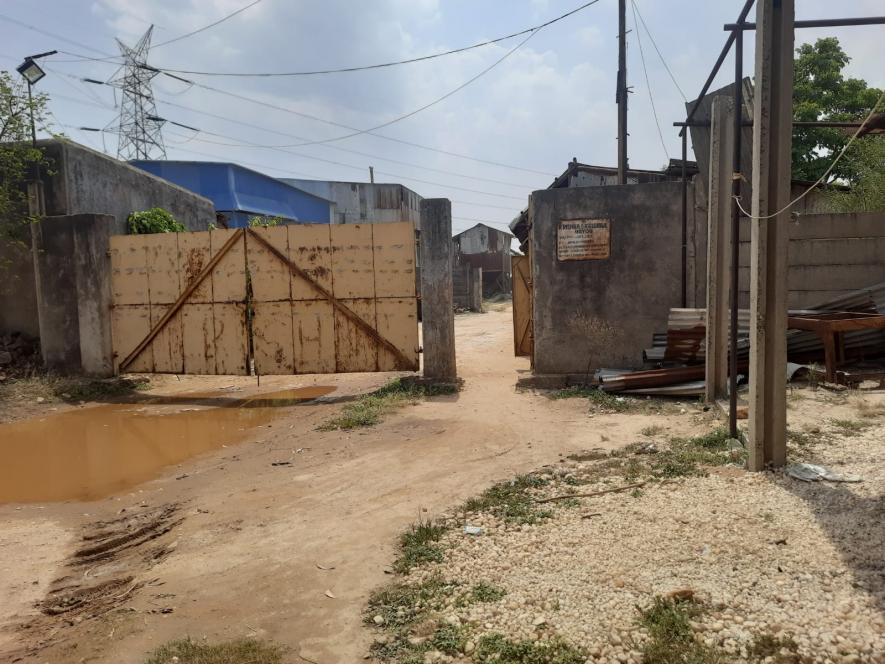
Krishna and Krishna Udyog, the factory that has operated using different names in different rural belts of East Singhbhum and continues to feed over the lives of helpless laborers.
The salary he was being paid was still insufficient to run the family; he was thinking of finding another job when the company owner came to his rescue. He was given additional responsibilities of looking after the production, and in return, he received a good hike.
Little did he know that with the hike came an additional dose of the silicon dioxide responsible for his condition today. The ramming mass factories use Quartzite stones, grind them into different-sized particles, and mix them with the other-sized particles to prepare 'ramming mass'.
This product is used in steel industries to create insulators and much more.
As the huge machine grinds the stone and brings a huge solid substance into a powder form, much dust is released. This dust contains silicon dioxide. When inhaled over some time, it leads to silicosis. This lung infection produces lung lesions that snatch the breathing capacity slowly and eventually lead to the patient choking out of breathlessness. It has three variants- acute, chronic, and accelerated. The stage depends on the silica intake of the patient. In ramming mass production, the silica dust content is 99%. Hence almost all the workers who end up with silicosis are in an acute stage.
A Vicious Cycle Moving Toward Death
Oblivious to the condition of her father, Kunal's daughter keeps hovering around him and asking him to play. Kunal would gently place his hand on her face and ask her to go to the other room. When the family's sole earning member is in bed, the house speaks for itself. The family is surviving on Kunal's late dad's pension money and the savings he had left for the family. The cry for help by his mother would leave any person disturbed.
"What was my son's fault? He came back from Bangalore because he wanted to stay with me. And this is what he got," she said.
Seeing Kunal gulp seven big tablets twice daily often makes the wife and mother tear up.
"When we learned he had silicosis, we contacted the company owner, who blamed my son. He said my son consumed alcohol and tobacco because of which he had the condition."
Kunal narrated how the owner's son would often smoke with him. With every word he uttered, he would struggle to breathe and hold the mask tighter to his mouth. In the last couple of days, his breathing problems have increased. He later realised why the factory owner would only stay within the premises briefly.
"They would just come and sit in the office, that too not for long," he said.
NewsClick contacted the former Director of ICMR (Indian Council for Medical Research), Kamalesh Sarkar. His expertise is in occupational health.
When asked about the impact of tobacco consumption on a silica dust-exposed worker, he said, "Both silica exposure and tobacco consumption damage the lungs. But with silicosis, it is different. In my years, as I made recommendations to Central and state governments, we realised that a certain protein secretion of the club cell decreases in a silica dust-exposed patient. If a test is done yearly, it can very well be differentiated."
Workers say that the owner would stop responding to their calls once they had fallen prey to the disease. With no proof of employment, the workers are left helpless to die.
Jagannath Pator (35) used to work at the same factory as Kunal as a labourer. His conditions were worse. He had been in the emergency ward for over a month when NewsClick met him.
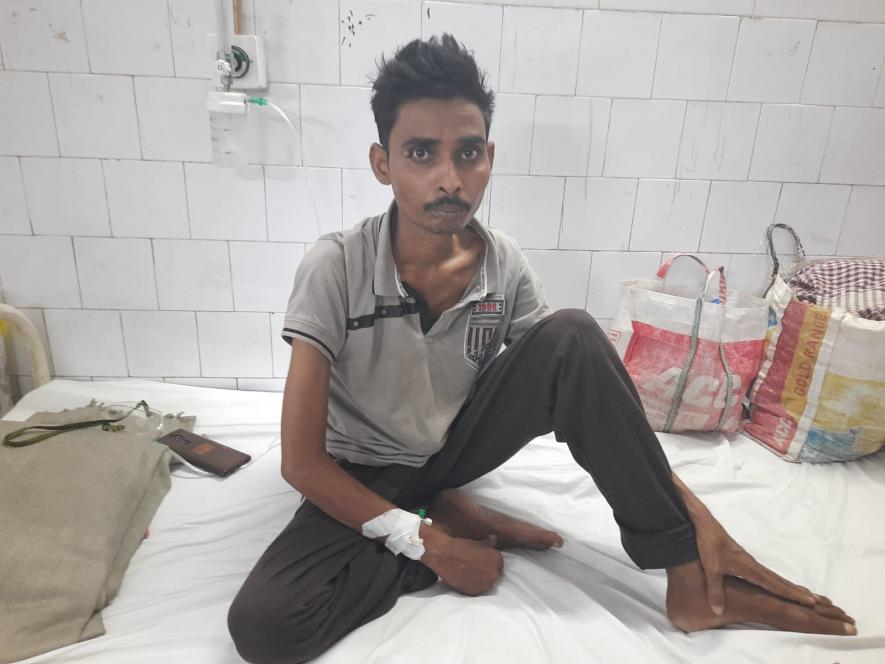
Jagannath Pator's condition has deteriorated to the extent that he cannot speak a full sentence without gasping for breath
MGM, a government hospital in Jamshedpur, depicts a typical picture of the healthcare infrastructure in government hospitals. The emergency ward is flooded with patients; beds are aligned not just in the ward but in the corridor as well.
Pator was made to stay in the emergency ward since there was no arrangement for oxygen in the common ward where better treatment could be meted out to him. He has two kids and used to live with his family in Musabani. He is a prime example of how workers are lured into this perilous work zone with money. While working there, he saw a few workers succumb to silicosis and got scared. He left the job and started working elsewhere to lead a healthy life.
But as the responsibilities called for more money, the wage at his new job failed to meet the family's ends. At that juncture, he received a call from his previous workplace. He was offered more money, and he went back to work there. One fine day, he realised that he could not breathe properly. Chest aches added to the difficulty, and Pator was hospitalised. It has been over nine months, and Pator cannot walk even a bare distance of 200 meters without halting for minutes, gasping for breath. His mother sits by him in the hospital bed, hoping her son will survive.
"I should not have gone back. I made a terrible decision that will now affect my family. I die every day seeing my family in this state, and I know that this disease is not stopping any time before taking my life," Pator said.
Ramming Mass: The Mass Murderer
In the past, reports have spoken in detail about the stone-crushing factories and the mining sites. But little has been spoken of ramming mass production used by the big steel industries and those involved in making insulators. The amount of silica dust involved is not spoken of much, whereas it is much higher than any other production that could release silica dust.
There have been media reports in the past where the deaths of scores of labourers have made it to the headlines in the local news channels. As a reaction, factories often shut down, or workers stop working when they realise the danger they are already in.
NewsClick found that the factory where Kunal and Pator worked used to run by a different name in a different location before they began operations in Dalbhumgarh. The factory earlier used to be run by KK Minerals and was now called Krishna and Krishna Udyog.
Just a difference in the name and a couple of more changes; in KK Minerals, labourers were given a pink slip as their attendance card, although it did not have any official signature, while here in the current Krishna and Krishna Udyog, no proof of attendance or employment at all. Another set of workers in a different location worked in similar and even more devastating working conditions. After Purnapani, the factory shifted to another area and operated in Dalbhumgarh.
In Purnapani, one after the other, as the workers in the area started to die, families of the deceased started to amplify a protest against the factory owners. A resident of Purnapani, Baso Sobo's (55) husband, used to work there back when the factory was operational.
"He was alright when he started working there. Initially, we thought our family's financial condition would improve as the owner paid more wages. But after working there for 2-3 years, my husband's health suddenly deteriorated. The doctors at MGM said he had tuberculosis and gave him medication for six months. Nothing changed; his health kept dropping. I remember it was in 2020 on a Sunday morning when he ultimately lost the capacity to breathe. He kept calling for help, started to lose control over his body, and eventually, died in front of my eyes," narrated Sobo.
The same was the condition with several other workers. Some passed away a few years back, and the others stopped working as they had started to face breathing problems. Even after the factory got shut, in a battle to get justice through compensation, the families of the deceased, as narrated by the villagers, booked a vehicle and travelled to Dalbhumgarh, where the factory currently operates. Kunal's words were confirmed by these villagers.
"We went twice, but the owner was never in the factory. There was no way we could reach out to him."
Over 30 km away from Musabani is Dalbhumgarh. To verify the villagers' claims and assess the factory conditions, NewsClick reached Krishna and Krishna Udyog. The factory was set in an area far from the habitation, between narrow lanes suited only for two-wheelers. A rusty board stuck to the wall with the name and other factory details.
A typical operational sound from a factory could be heard. There were either huge stones or grass in the area. Inside, to the right, was the security guard's room. On the left was an air-conditioned office, and in front was the huge plant where ramming mass was produced.
When the reporter entered the workplace, workers began their lunchtime. The factory supervisor sat inside the office and greeted the reporter with a grin. As the conversation proceeded, the supervisor gave details that joined certain dots.
"The factory was earlier in Purnapani. The owner is the same," he said with pride. "They are all brothers from a Marwari family by the surname Gupta. Previously, it was under the name of Prem Gupta and now under Viman Gupta."
He revealed that the villagers forcibly shut the factory in Purnapani. However, he did not talk about why the villagers were enraged.
The supervisor said that none of the workers in the factory were from far-flung areas; they were all local. This is how the factory has always operated, seeking a workforce from the nearby villages. On asking whether they were employees, the suspicious supervisor said, "We do not keep permanent employees. Approximately 15 workers work in one shift, and all of them are paid daily."
The victims' families must have been enraged because there was no source to prove that these workers were employed by the said company. Furthermore, the company never registered the employees under the ESI (Employee's State Insurance Corporation), which could help them get compensation and proof of their employment. Even for the ones like Kunal, who was comparatively at a better post, there was no offer letter or email that certified him joining the company, although he did have an ESI.
When asked about visiting and looking at the plant, the supervisor seemed hesitant. He called the owner Viman Gupta for permission, who didn't realise that the phone was on speaker and ordered the supervisor to guide everyone to say positive things.
Huge grinding machines, conveyor belts, sand-like powder on the floor, and sacks of packed ramming mass could be seen on the factory premises. Outside the huge production room, in the open, was the humongous pile of quartzite stones ground into particles below 5 microns and up to below 0.5 microns.
The workers on shift were having lunch. They travelled over 20 km every day to reach the workplace. When the reporter asked them if they had any employment proof, they were unaware that this was a norm to be followed for their safety.
When asked about the safety gear, the workers smiled feebly, indicating little care was taken. One used 4 N95 masks and said the dust still penetrated the nose. While the other, who wore only one mask, held it in his hand and claimed it made no difference.
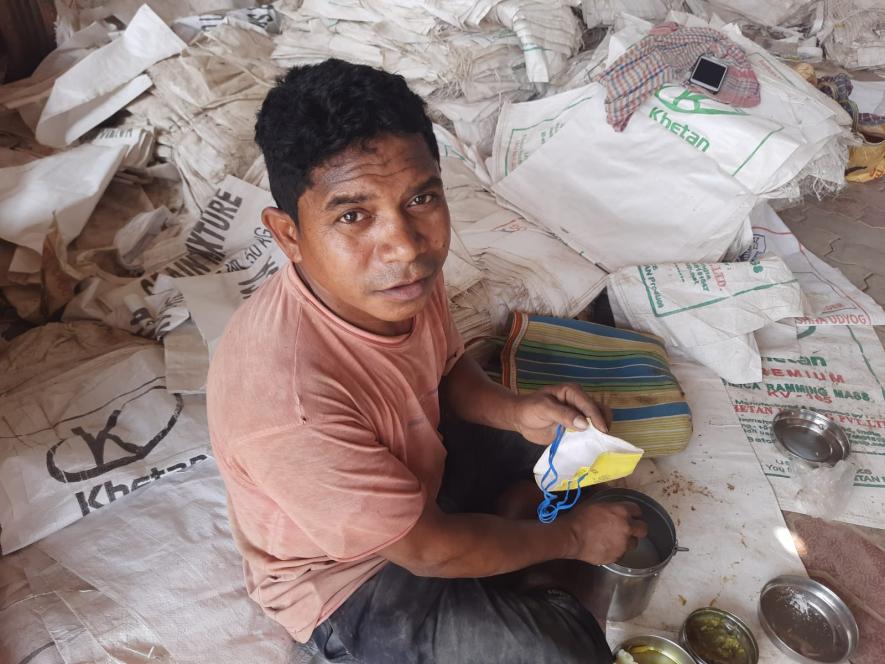
A worker inside the factory. He uses just one mask because he has trouble breathing and has to take the mask off at regular intervals in any case.
A few miles away from the factory was the village belt of Panijhi. Reportedly, at least four workers working in the factory who recently passed away were from this village belt. After hours of searching, the reporter came across an old survivor who used to work at the factory.
The old lady had worked there only for a couple of months. Her job was to seal the sacks of finished products. She elaborated on the working conditions. "
There is so much dust that you cannot even see the person in front of you. Often, your eyes would shut automatically. The masks are of little use because one would have to take them off owing to heat inside the factory and the breathlessness contributed by the dust."
When the question regarding these masks compared to the dust in the industry was posed to Sarkar, he said, "These N-95 masks are designed in a way that after a while, one would have to take it off to gather their breath. And if a person wears more than one, they would do it more often. And when working within the dust, they have no choice."
At one point in the Panijhi belt, settlements seemed to have ended as all that lay in front was wooded; the locals indicated that many who still worked at the factory resided within a village nearly impossible for the unknown to trace. The village is called Jarpogoda. The villagers were unfamiliar with welcoming strangers and seemed apprehensive about sharing details. After the accompanying source calmed them down, talking in the local dialect, they opened up.
All the workers who were still working there were not home. The houses in the village were deprived of the necessities. Working at the factory had brought hope for some and death for many.
The ones who learned from the deceased of the others had stopped working. Others failing to find a different job were still going. Mahender's mother is one of them.
"I stop my mother every day from going there. I tell her nobody who has worked there for a few months survives, but she does not listen. She brings up the question of survival, and I am silenced." They are in a situation where Purnapani was a couple of years back. Workers falling prey, a few falling sick, and the least realising what the working conditions would lead to in the near future.
Around six months back, Rupali (35) used to work there. She stopped working when she started to face breathing problems and chest aches. She coughed and tried taking long breaths as she talked. After a while, she could no longer stop and sat on the floor.
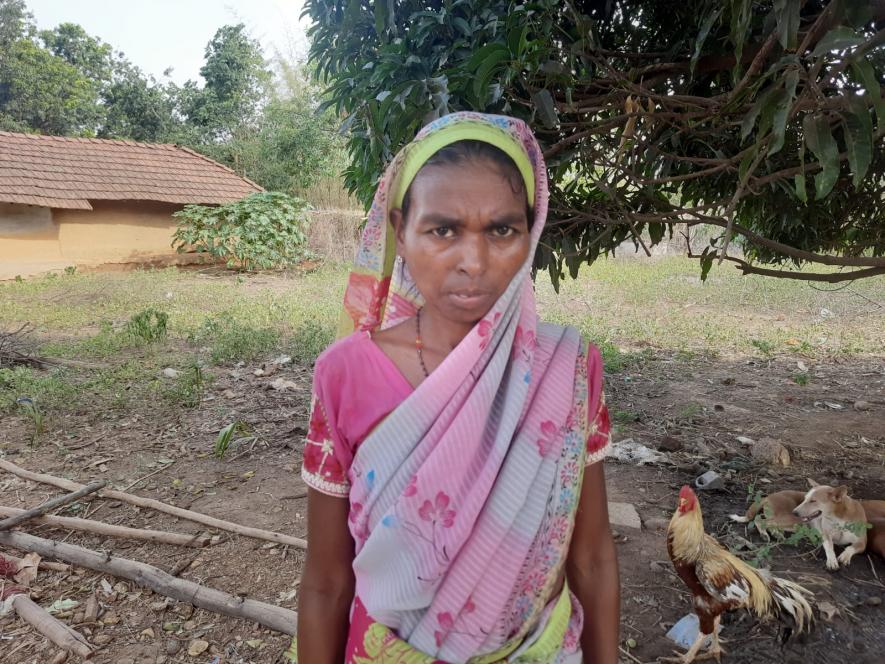
Rupali's health is dropping bit by bit, she left working six months back owing to her illness.
With each passing month, her health keeps deteriorating. When the reporter showed Rupali the picture of the factory and the employees he met at lunch, she immediately recognised them.
NewsClick spoke with families of at least 25 workers who are or have been in any way associated with such factories. All concluded that there was no control over the dust, they received no proof of their employment, and the factory owners paid little heed to the workers who fell sick and never returned. Another major conclusion was that none of these workers knew what could happen to them until they saw people die in front of their eyes.
Many of these workers were told by the doctors at the MGM Hospital, Jamshedpur, that they suffered from Tuberculosis(TB). As per Sarkar, some of these deductions are inadvertently wrong, while for most of it, it is to narrow down the numbers of silicosis patients and hence the compensation to be paid.
Their TB treatment would continue for 6-9 months and see no impact. In going through the available medical reports of a few workers, NewsClick found something that raised grave questions.
In Pator's report, twice, he was first declared to have silicosis, and later, in the report itself, the term silicosis was cancelled, and a broader term of lung disease 'pneumoconioses' was used. Penumo stands for air, meaning lungs; con stands for particles meaning dust particles, hence the disease of the lungs. It is a very broad term.
Seeking answers to the possible reasons why this could be done, NewsClick reached out to Samit Carr, a man fighting for the rights of these patients. He also runs an organisation called OSHAJ which caters to occupational health.
"Writing silicosis would prove that the worker has been infected in the workplace. It is not a mistake. It is a way to get away without paying compensation," said Carr.
He also confirmed that this was not the first time the patients were not being termed under silicosis. In his experience, he had dealt with similar situations and fought the administration, after which they diagnosed the patients with silicosis.
In Kunal's case, Carr says, "It was as if all his details, including his address, Aadhar number, PAN number, and everything was written on a form but not his name."
All the conditions that derive silicosis could be seen in the report, but silicosis was not written. A major condition in the policy introduced by the Jharkhand government mandates silicosis to be written in the report if the worker were to get compensation from the state.
"Restrictive lung disease, chronic respiratory failure, extension bullous lesion, and distorted lung' accompanied by the occupational history of Kunal, where he had exposure to 99% silica dust as he worked at a ramming mass factory, was shown in the report. However, the term was not mentioned."
Policies are in, Workers out of Them
Most of the survivors and the families of the deceased are unaware if they are entitled to compensation. No periodical test was done either, which could confirm whether these employees fell under the occupational disease category.
The Factories Act of 1948 recognises silicosis as a notifiable disease, meaning for any person affected by silicosis, the report must be given to the government. The most basic benefit that these workers involved in the production of ramming mass are entitled to be under chapter 5 of the ESI(Employees' State Insurance Act) 1948.
However, as per the current conditions observed in the factory the reporter visited, it has been several months since the workers started working there, and even the ones like Rupali, who stopped working owing to their sickness, do not have an ESI card.
In the recent past, the Jharkhand government has granted compensation to over 40 workers of Rs 4 lakh as recommended by the NHRC (National Human Rights Commission). This happened when Carr wrote several letters to the NHRC and submitted reports of the patients who were either deceased or suffering from silicosis.
Even the Workmen Compensation Act recognises permanent and partial disability, but the lack of proof of being an employee has given the factory owners a guilt-free pass. The damage and the disability can be judged by the amount of lung damage visible in the screening.
However, the government's delay and negligence can be established via its data. As assessed by NewsClick, in 2014, the Jharkhand government recognised 27 patients affected by silicosis. Compensation was rewarded to five out of these 27. In the years to come, until April 2023, two more patients died while 20 remained alive. However, these 20 have yet to receive any compensation. Even though the state government 2021 introduced a policy for silicosis-affected workers.
Although the policy has a major demerit, the workers have fallen into a vicious cycle where gaining mere compensation has become nearly impossible. Firstly, none of these workers have proof of their employment. Furthermore, hospitals often do not even recognise the disease to be silicosis. Sarkar talked about how any MBBS doctor could diagnose a patient with silicosis.
"There are two things that confirm silicosis in a patient- first, the patient's occupational history. Seeing that the place where the patient worked had silica dust exposure, it is easy to identify. Secondly, since silicosis is a progressive disease, a critical passive white opacity on the lungs, a shadow over the chest on the X-ray, shows that a person has silicosis. When both of these are present, it can be diagnosed as silicosis."
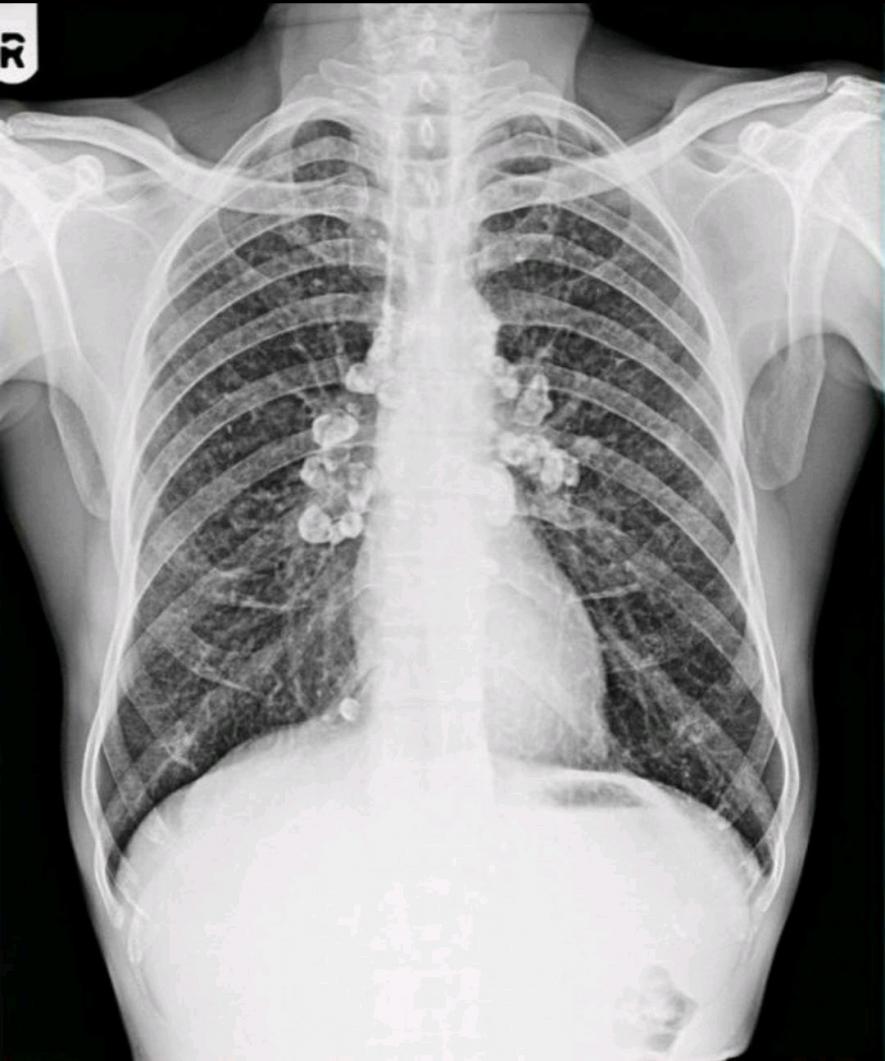
An X-ray of the lungs of a silicosis patient.
About the people who are missing from the government's list of silicosis, the most responsible factor is the absence of periodic tests. There are high chances that initially, the doctors would fail to detect silicosis. But another test after six months or a year, when the lung damage is much more, silicosis will be detected. Such cases can be seen in Jharkhand as well. In the case of Badal Karmakar, a resident of Purnapani, he initially did not fall under the bracket of silicosis, but after regular tests by OSHAJ, a foundation run by Carr, it was found years later that he had silicosis.
Sarkar also narrated how the government was planning and implementing policies to eliminate TB by 2025, but there was no mention of underlying silicosis anywhere.
The world is yet to see a treatment for silicosis because it is impossible to reverse lung damage. Meanwhile, factories in Jharkhand continue to operate in unsafe conditions, oblivious and poor workers from extreme rural belts continue to fall into the money trap, and their families weep in silence, awaiting justice to be served.
Get the latest reports & analysis with people's perspective on Protests, movements & deep analytical videos, discussions of the current affairs in your Telegram app. Subscribe to NewsClick's Telegram channel & get Real-Time updates on stories, as they get published on our website.









